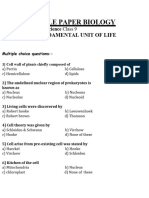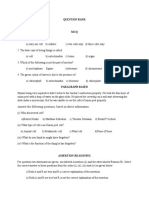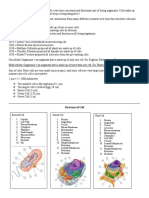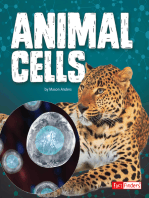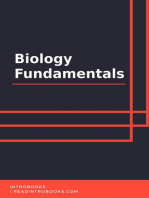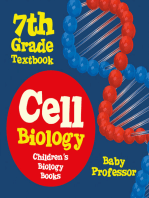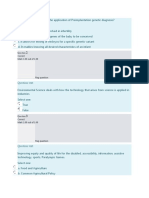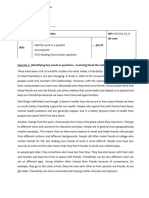Additional Notes On Cells
Uploaded by
dpa2252895Additional Notes On Cells
Uploaded by
dpa2252895CELLS
BASIC CELL TYPES:
1. ________________ (from the Greek “pro”- before and “karyon” – "nut" or "kernel", here meaning "nucleus")
- Cells that lack a membrane-bound nucleus therefore they do not have a true nucleus. DNA in a
prokaryotic cell is not separated from the rest of the cell but coiled up in a region called the nucleoid.
- Have few internal structures that are distinguishable under a microscope
Bacteria perform many important functions on earth. They serve as decomposers, agents of fermentation, and
play an important role in our own digestive system. Also, bacteria are involved in many nutrient cycles such as
the nitrogen cycle, which restores nitrate into the soil for plants. Unlike eukaryotic cells that depend on oxygen
for their metabolism, prokaryotic cells enjoy a diverse array of metabolic functions. For example, some bacteria
use sulfur instead of oxygen in their metabolism.
2. ________________ (“Eu” – “true”. Therefore = “truly nuclear” or has true nucleus)
- Contain many internal membrane-bound structures called _________. These ____________ such as
the mitochondrion or chloroplast serve to perform metabolic functions and energy conversion. Other
________________ like intracellular filaments provide structural support and cellular motility. Another
important member of the eukaryote family is the plant cell.
- They grow and reproduce through a process called __________. In organisms that also reproduce
sexually, the reproductive cells are produced by a type of cell division called _____________.
- Most prokaryotes reproduce through a process called _________________. During this, the single DNA
molecule replicates and the original cell is divided into two identical daughter cells. Both eukaryotic and
prokaryotic organisms get the energy they need to grow and maintain normal cellular function through
cellular respiration. Cellular respiration has three main stages: glycolysis, the citric acid cycle, and
electron transport. In eukaryotes, most cellular respiration reactions take place within the mitochondria.
In prokaryotes, they occur in the cytoplasm and/or within the cell membrane.
Three unique structures which set plant cells apart: __________, _____ _______, and ___________.
MORPHOLOGY AND FUNCTION OF CELLS
1. ___________ – a rigid, external layer that is specifically designed to provide structural support and rigidity.
2. __________________ - thin semi-permeable membrane that surrounds the cytoplasm of a cell
- Structure is primarily composed of a mix of proteins and lipids.
- Function: protect the integrity of the interior of the cell by allowing certain substances into the cell,
while keeping other substances out.
- It serves as a ________________ for the cytoskeleton in some organisms and the cell wall in others.
- Animal cells, plant cells, prokaryotic cells, and fungal cells have this.
- Structure is primarily composed of a mix of ____________ and
____________.
- _________________ are a major component of cell membranes.
o They form a lipid bilayer in which their hydrophilic head
(attracted to water) areas spontaneously arrange to face the
aqueous cytosol and the extracellular fluid, while their
hydrophobic tail (repelled by water) areas face away from the
cytosol and extracellular fluid.
o Glycolipids are located on cell membrane surfaces. They help
the cell to recognize other cells of the body.
3. ___________________ – composed mainly of water and also contains enzymes, salts, organelles, and
various organic molecules. It helps to move materials around the cell and also dissolves cellular waste.
4. Mitochondria (________________) - are the cell's power producers
- They convert energy into forms that are usable by the cell.
- Sites of cellular respiration which ultimately generates fuel for the cell's activities
5. ______________ - responsible for protein production via translation
- they are typically composed of two subunits: a large subunit and a small subunit.
- _________________________ are synthesized by the nucleolus.
6. _____________________________________
- serves important functions particularly in the synthesis, folding, modification, and transport of proteins.
- There are two regions of the this that differ in both structure and function:
➢ Rough ER: studded with millions of membranes bound ribosomes, involved with the production,
folding, quality control and dispatch of some _______________.
➢ Smooth ER: largely associated with _________ (_______) manufacture and metabolism and steroid
hormone production.
7. __________ ____________/ ________ - is composed of flat sacs known as __________.
- functions as a factory in which proteins received from the ER are further processed and sorted for
transport to their eventual destinations: lysosomes, the plasma membrane, or secretion.
8. ________________ – a type of plastid (a saclike organelle with a double membrane) that serves as the
site of photosynthesis.
9. Vacuole- a membrane-bound cell organelle.
- In animal cells, they are generally small and help sequester waste products. In plant cells, vacuoles
help maintain water balance. Sometimes a single vacuole can take up most of the interior space of
the plant cell.
10. _____________________ - control all the function of the cell (including cell growth and reproduction)
hence the nucleus is called as the brain of the cell.
- The nucleus is bounded by a double membrane called the nuclear envelope. This membrane separates
the contents of the nucleus from the cytoplasm. A denser, definitely circumscribed region of protoplasm
containing nucleoplasm which consists of gels of varying consistency containing chromatin, a
substance staining heavily with certain basic dyes, adhering in the form of granules to a network of
linin.
11. _______________________ - are also located in the nucleus that house cellular DNA.
- When a cell is "resting" i.e. not dividing, the chromosomes are organized into long entangled structures
called chromatin.
o Chromatin is a mixture of ___________ and _____________ that form the chromosomes found in
the cells of humans and other higher organisms.
12. _________________ – double-membrane organelles which are found in the cells of plants and algae.
- They are responsible for manufacturing and storing of food.
You might also like
- AP Biology Name - Chapter 6 Guided Reading Assignment33% (3)AP Biology Name - Chapter 6 Guided Reading Assignment6 pages
- Cell Structure - Function Review With AnswersNo ratings yetCell Structure - Function Review With Answers9 pages
- BioCellStructureandFunctionGuidedNotes-1No ratings yetBioCellStructureandFunctionGuidedNotes-113 pages
- CBSE Class IX Biology Fundament Unit of Life Chapter NotesNo ratings yetCBSE Class IX Biology Fundament Unit of Life Chapter Notes7 pages
- Internal Structure of Cells (A) Diagram of Prokaryotes (B) Diagram of EukaryotesNo ratings yetInternal Structure of Cells (A) Diagram of Prokaryotes (B) Diagram of Eukaryotes3 pages
- CELL_6210570b-55c2-471e-a451-4b3dbef54a4fNo ratings yetCELL_6210570b-55c2-471e-a451-4b3dbef54a4f4 pages
- Greenwood--updatess--2020-04-10-05-32-am30--BIO,CH-5,CL-9No ratings yetGreenwood--updatess--2020-04-10-05-32-am30--BIO,CH-5,CL-93 pages
- Biology 1: Cell Theory Cell Structure and FunctionsNo ratings yetBiology 1: Cell Theory Cell Structure and Functions4 pages
- AY 2018 - 2019 Biology Preliminary Exams Semester INo ratings yetAY 2018 - 2019 Biology Preliminary Exams Semester I10 pages
- Biology 12 - The Cell - REVIEW WORKSHEET: Name: Block: DateNo ratings yetBiology 12 - The Cell - REVIEW WORKSHEET: Name: Block: Date4 pages
- Ppt-Gcordi Chapter 2 (Layers of Cordillera Identity)No ratings yetPpt-Gcordi Chapter 2 (Layers of Cordillera Identity)64 pages
- CBSE NCERT Solutions Class IX Science Atoms and MoleculesNo ratings yetCBSE NCERT Solutions Class IX Science Atoms and Molecules10 pages
- Botulinum Toxin Therapy Scott M. Whitcup (Editor) 2024 Scribd Download100% (6)Botulinum Toxin Therapy Scott M. Whitcup (Editor) 2024 Scribd Download62 pages
- Radiated Tortoises - Geochelone (Astrochelys) Radiata - Chris Tabaka DVM andNo ratings yetRadiated Tortoises - Geochelone (Astrochelys) Radiata - Chris Tabaka DVM and10 pages
- Sequencing Depth and Coverage: Key Considerations in Genomic AnalysesNo ratings yetSequencing Depth and Coverage: Key Considerations in Genomic Analyses12 pages
- Follicle Stimulating Hormone (FSH) ELISA: For The Quantitative Determination of FSH in Human SerumNo ratings yetFollicle Stimulating Hormone (FSH) ELISA: For The Quantitative Determination of FSH in Human Serum7 pages
- The Structures of The Human Body and Its FunctionsNo ratings yetThe Structures of The Human Body and Its Functions4 pages
- Principles of Wildlife Management (Lec 1)No ratings yetPrinciples of Wildlife Management (Lec 1)20 pages
- Risk Management in Health Care Institutions 3rd By Florence Kavaler pdf downloadNo ratings yetRisk Management in Health Care Institutions 3rd By Florence Kavaler pdf download28 pages
- Identification of Important Pests and Diseases in My LocalityNo ratings yetIdentification of Important Pests and Diseases in My Locality3 pages
- Course Outline - Molecular Biology - 2023 - 023100No ratings yetCourse Outline - Molecular Biology - 2023 - 0231004 pages
- Question Text: Correct Mark 1.00 Out of 1.00No ratings yetQuestion Text: Correct Mark 1.00 Out of 1.0022 pages
- Human Nutrition Classified Past Paper 2 Solved IGCSE Biology 0610 GCSE O Level100% (1)Human Nutrition Classified Past Paper 2 Solved IGCSE Biology 0610 GCSE O Level38 pages
- Animal Health Care and Management Laboratory Exercise 4 Handle and Store Drugs and BiologicsNo ratings yetAnimal Health Care and Management Laboratory Exercise 4 Handle and Store Drugs and Biologics4 pages
- WS1 Deer Habitat Impact Activity Survey GuideNo ratings yetWS1 Deer Habitat Impact Activity Survey Guide25 pages






















